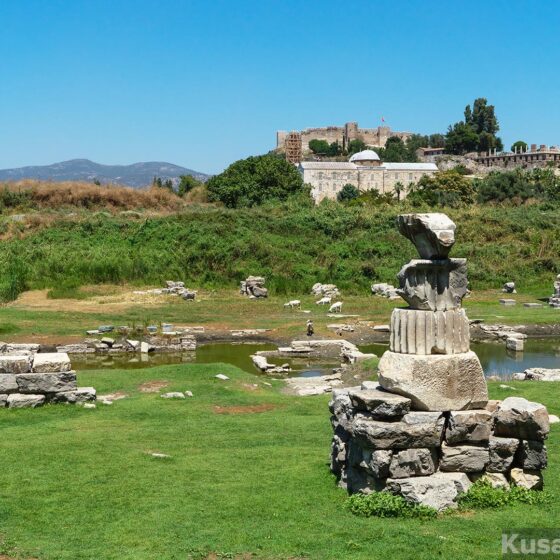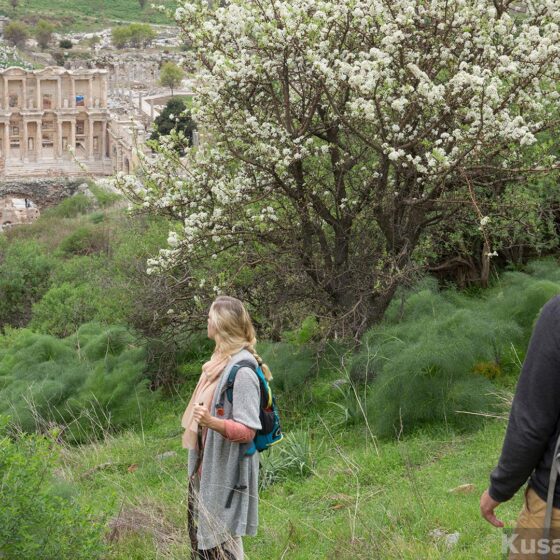Table of Contents Show
Ephesus’s temples are quiet reminders of the past. Their stones hold stories of old faith. Why do these sites attract you? They link to the town’s lively coast. This guide offers clear facts and tips. It will enrich your 2025 visit. Let’s explore these paths together!
Ephesus was a key religious hub long ago. Its temples were places of worship, community, and trade centers. They’re near Kusadasi, a short dolmus ride away. Major temples, like the Temple of Artemis, were stunning. Smaller shrines and Christian sites added depth. Here’s what to know.
Major Temples: Ephesus’s Grand Shrines
Ephesus’s major temples drew pilgrims. They shaped its past. The Temple of Artemis, or Artemision, was huge. It was one of the Seven Wonders. Now, it’s a single column in Selcuk. Storks nest there. It honored Artemis, the goddess of fertility and hunting. Visitors boosted the economy. It’s a short dolmus ride away. In 2025, new signs explain its history. This makes it essential. It ties to Kusadasi’s heritage.
The Temple of Serapis came later. It honored the Greco-Egyptian god Serapis. Its faint columns show Ephesus’s mix of cultures. It welcomed diverse worshippers. Its rituals reflected this blend. It’s a quick dolmus trip away. In 2025, guides highlight its role. They connect it to the region’s past.
The Temple of Domitian, from the late 1st century CE, honored Emperor Domitian. Its platform, near the Upper Agora, marked Rome’s imperial cult. It held rituals for the emperor. This showed Roman power. It’s a short dolmus ride away. In 2025, new markers note its politics. They link to Kusadasi’s history.
The Temple of Hadrian, from the 2nd century CE, celebrated Emperor Hadrian. Its Corinthian columns and reliefs symbolized Ephesus’s Roman loyalty. It’s near Curetes Street. It was a civic pride spot. It’s a brief dolmus trip away. In 2025, fresh paths highlight its art. They connect to the coast’s energy.
Smaller Shrines and Altars: Ephesus’s Quiet Corners
Ephesus had smaller shrines, too. They added to its spiritual diversity near Kusadasi. The Temple of Isis honored the Egyptian goddess of motherhood. Its faint stones show Egyptian influence. It’s a short dolmus ride away. In 2025, new plaques explain its healing rituals. They link to the region’s past.
The Temple of Cybele honored the Anatolian mother goddess of fertility. Its ancient roots came before the Greeks. Now, it’s faint traces nearby. It’s a quick dolmus hop away. In 2025, guides note its nature ties. They connect to Kusadasi’s heritage.
Christian Heritage: Ephesus’s New Faith
Ephesus’s Christian shift brought the Basilica of St. John. It’s from the 6th century CE. It’s over John the Apostle’s tomb. Its arches offer calm. It’s a short dolmus ride away. In 2025, new signs highlight its faith role. They link to the coast’s pulse. Summer’s busy. Spring’s quiet for reflection.
Beliefs, Rituals, and Faith: Ephesus’s Spiritual Heart
Ephesus’s faith was diverse. Artemis led as goddess of fertility and wildlife. Her temple drew pilgrims. It’s a short dolmus trip away. Apollo, god of light, and Cybele, mother of nature, shaped its spirit. They’re key to its identity. They connect to Kusadasi’s past. Rituals, like music and offerings at Artemis’s site, united people. Mystery cults, like Cybele’s, offered secrets. They fostered community ties nearby. Christianity changed this. Paul’s teachings in Selcuk united faiths. The 431 CE Council of Ephesus clarified Christ’s nature. It’s vital for its legacy. It ties to Kusadasi’s roots. In 2025, guides explain these beliefs. They show their depth. They urge love and unity today. Check local libraries for Paul’s letters. This deepens understanding.
Archaeology, Culture, and Impact: Ephesus’s Lasting Pull
Ephesus’s temples reveal their past through archaeology, like the Temple of Artemis, uncovered in 1869 by John Turtle Wood, now a lone column, buried 20 feet deep then, a short dolmus trip away. In 2025, new digs add insights, with artefacts in London’s British Museum, a key stop for its history, tying to Kusadasi’s buzz. Its cultural echo shaped Greek art and tourism, its designs influencing architecture, drawing millions in 2025 under UNESCO status since 2015, connecting to Kusadasi’s culture. Its stone styles, from Cyclades’ plain lines to Peloponnese’s carvings, and art like inscriptions on local gods, show its depth. At the same time, myths of Artemis, Apollo, and Cybele, community rituals, and temple trade boosted its economy, linking to the coast’s past. In 2025, its legacy is preserved for visitors and shown in local events.
Why do Ephesus’s temples, stretching to these gems, deepen your Kusadasi stay? As you sit by the marina, sea murmuring, picture sketching Artemis’s column, pondering Hadrian’s art, or reflecting at St. John’s—faith ties Kusadasi to its heart. It’s not just sightseeing. It’s Turkey’s spirit lighting up your trip. Will you tread its paths? Share your temple tale below. We’re all ears, eager for your story.
Last updated on March 4, 2025



